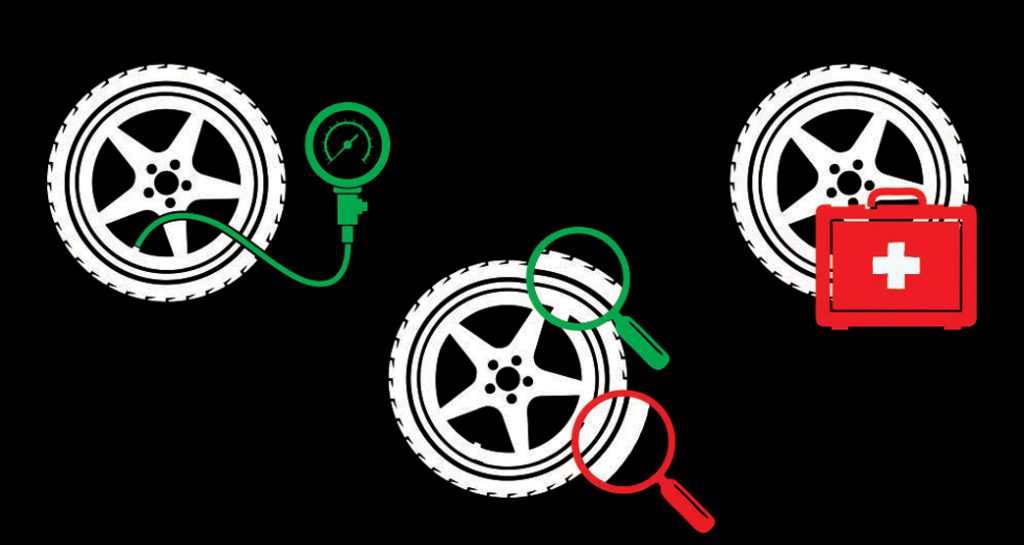
Significance Of Tire Pressure
Proper tire inflation is crucial for safety as it slows down rapid deterioration that results in early tire replacement. Underinflated tires produce abnormal heat levels while being driven, which may eventually cause the tire to weaken to the point of failure. Rapid tire deflation can result in a loss of control at high speeds. Uneven tire wear and a rough ride feel are both effects of over-inflated tires. The advantages of maintaining properly inflated tires are numerous. It may lead to longer tire life and better vehicle fuel efficiency. Cars will provide a more pleasant ride, and provide consistent traction with properly inflated tires. There are a few tire inflation-related facts that are quite significant. The tire pressure must be adjusted in accordance with the owner’s handbook for the vehicle or in accordance with the tire information placard. Preferably, tire pressure should be checked in the morning before driving the vehicle. If the reading is taken after the vehicle has been driven, it is impossible to tell which reading is accurate.
Temperature variations have an impact on tire pressure. The tire pressure will drop when the temperature is cold and rise when the climate is warm. It is important to check the pressure of tires with seasonal changes and a good-quality gauge should be used. Newer model cars are now equipped with a tire pressure monitoring system (TPMS) that will automatically alert the driver when a tire’s pressure is low. A tire pressure gauge should always be kept in the glove box of a car, even if it includes a tire pressure monitoring system (TPMS). One gauge should be used for the sake of consistency as using many gauges might result in a broad range of values.
Moreover, tires must be inflated in accordance with the advice of the automobile manufacturer. Tires that are overinflated will become rigid and stiff, which will reduce the tire’s contact area. The tire’s center might wear out faster than the sides, causing uneven wear, notably increased center wear. Conversely, underinflated tires flatten down and make greater contact with the road because of this. Tires that are underinflated also reduce a car’s fuel efficiency. Consistently monitoring tire pressure and ensuring they are suitably inflated are two of the most neglected steps that automobile owners do not do to maintain their vehicles. A safety risk at high speeds is inadequate tire pressure, which can result in issues including higher rolling resistance, increased fuel consumption, and anomalous tire wear.

The image above demonstrates how tire contact patch varies as the pressure changes. The contact patch will be small if the tire is overinflated, which will affect how the automobile handles. Due to the road being in contact with the center of the tread, the tire’s center will likewise deteriorate more quickly. When a tire is underinflated, its side will deteriorate more quickly, and rolling resistance will rise. In order to move the vehicle, the engine will have to work harder, resulting in increased fuel consumption and higher CO2 emissions.
Both safety and tire longevity depend on having the proper tire pressure. Prior to any long-distance drive, all tires, including the spare, should have their pressure checked once a month. The internal and exterior condition of the tire, as well as the state of the wheel and valve, should all be examined in the event of an unexpected pressure drop. Road safety depends on having the best possible traction. Under-inflated tires can cause a vehicle to handle poorly as well as overheat and increase the risk of a tire bursting. Tires that are overinflated or underinflated need to be changed more frequently and sustain more damage than tires that are inflated properly. Even a typical 60% inflation level can dramatically decrease tire life and increase tire wear. Under-inflated tires increase rolling resistance, which means it takes more fuel to keep a vehicle moving at a constant pace. Optimized fuel efficiency is maintained with proper tire pressure. This reduces CO2 emissions from automobiles and contributes to environmental protection. Numerous crucial aspects of a vehicle’s performance, including comfort while driving, directional stability, cornering and braking grip, as well as overall handling behavior, are influenced by tire pressure. One or more of these significant features will suffer if you drive with improper tire pressure. In order to achieve maximum performance, it is crucial to often check the tire pressure.
The vehicle’s recommended tire pressures are determined by depending upon cold inflation pressure. When a gas is heated, it expands and shrinks as the temperature changes. Accordingly, tire pressure must be checked in the morning, before the tire has been driven on, before the air temperature increases, and before exposure to the sun. The pressure within heated tires will be higher as driving generates heat. Therefore, you should never lower the pressure in warm tires, and doing so might result in the pressure dropping below the minimum tire pressure when the tires have cooled. Checking tire pressure is especially crucial in the fall and winter when temperatures decrease. The tires’ pressure may decrease by roughly 5 psi in the winter, which has an impact on their grip, handling, and longevity. Due to this seasonal variation, it is advised to check the tires’ air pressure at the beginning of each month and before lengthy road journeys, as the added load may necessitate raising the pressures to the recommended level. Also, it is an essential measure to have a spare tire.
SOURCES
- HOW TO CHECK TYRE PRESSURE | Just Tyres. (n.d.). https://www.justtyres.co.uk/tyre-tips/how-to-check-tyre-pressure
- Brothers, B. (2017, May 8). The Importance of Proper Tire Inflation. Burt Brothers. https://burtbrothers.com/blog/importance-proper-tire-inflation/



Leave a Reply